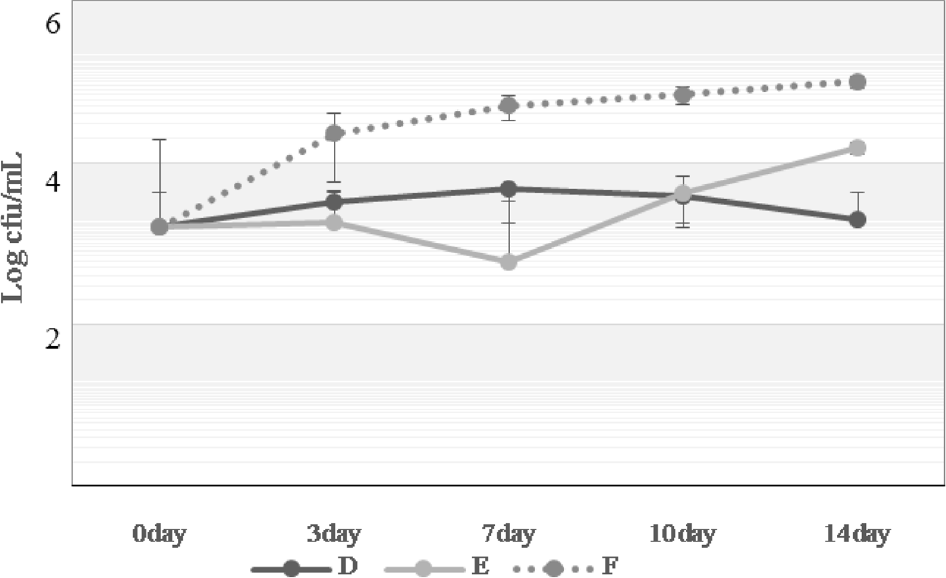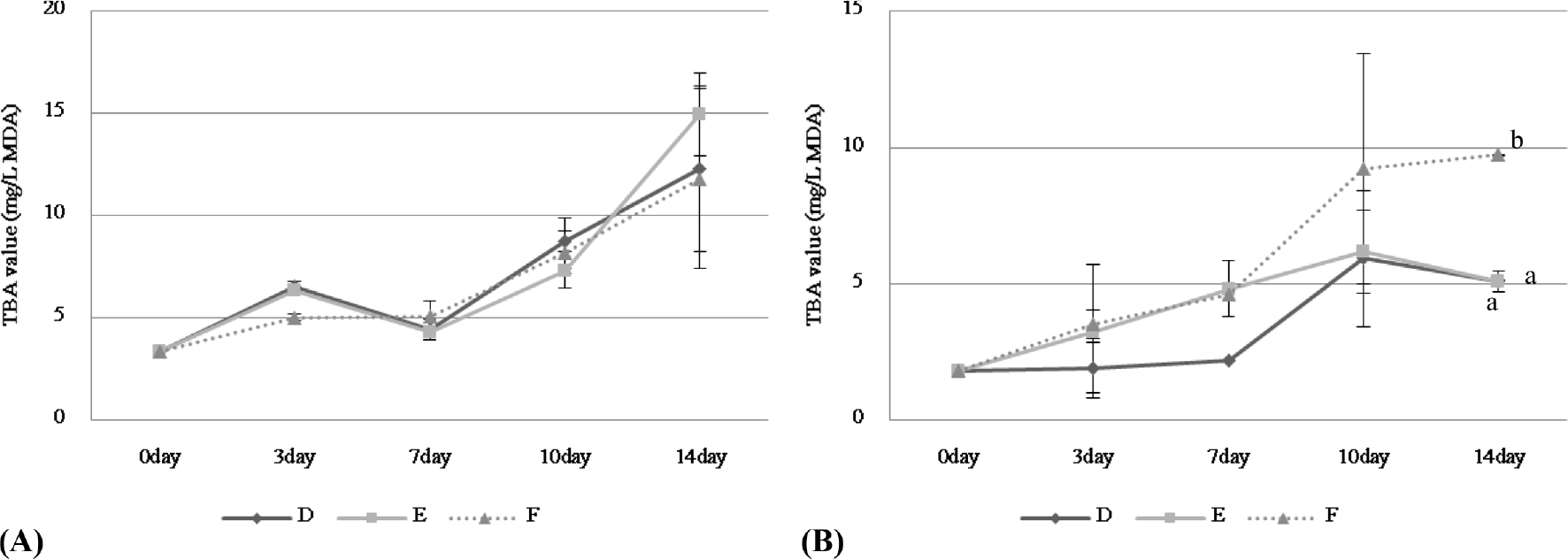Abstract
Purpose
The objective of this study was to examine the association of temperature-fluctuation with freshness quality in various foods. Methods: We investigated the effects of storage conditions on antioxidant activities of cherries and romaine lettuce during storage at 0.7 ± 0.6oC, 1.2 ± 1.4oC, and 1.6 ± 2.8oC. Cherries and romaine lettuce were stored for a period of 9 days and 7 days, respectively. We also analyzed the effects of storage conditions on fresh quality of beef and salmon during storage at −0.3 ± 0.8oC, −0.6 ± 2.3oC, and −1.5 ± 4.4oC. Both of them were stored for a period of 14 days. Results: The amount of water loss was highest in beef, and the microbial count was also the highest at −1.5 ± 4.4oC. In the case of salmon, there was no difference in water loss according to storage, and TBA value was significantly increased at −1.5 ± 4.4oC. Moisture retention was the highest at 0.7 ± 0.6oC in both romaine lettuce and cherry samples. The contents of polyphenol and flavonoid were significantly higher in cherries, and content of polyphenols in romaine lettuce was significantly higher at 0.7 ± 0.6oC (p < 0.05). DPPH activity decreased in the order of 0.7 ± 0.6oC > 1.2 ± 1.4oC > 1.6 ± 2.8oC over 7 days. Conclusion: The results indicate that temperature-fluctuation may affect qualities of foods stored in a refrigerator.
Go to : 
References
1. Hall MK, Jobling JJ, Rogers GS. Influence of storage temperature on the seasonal shelf life of perennial wall rocket and annual garden rocket. Int J Veg Sci. 2013; 19(1):83–95.

2. Henry HA, Juarez JD, Field CB, Vitousek PM. Interactive effects of elevated CO2, N deposition and climate change on extracellular enzyme activity and soil density fractionation in a California annual grassland. Glob Chang Biol. 2005; 11(10):1808–1815.

3. Koukounaras A, Siomos A, Sfakiotakis E. Postharvest CO2 and ethylene production and quality of rocket (Eruca sativa Mill.) leaves as affected by leaf age and storage temperature. Postharvest Biol Technol. 2007; 46(2):167–173.

4. Park HJ, Lee MJ, Lee HR. Vitamin C and antioxidant capacity stability in cherry and romaine during storage at different temperatures. J Nutr Health. 2016; 49(1):51–58.

5. Nielsen T, Bergström B, Borch E. The origin of off-odours in packaged rucola (Eruca sativa). Food Chem. 2008; 110(1):96–105.

6. Shin PG, Chang AC, Hong SC, Lee KS, Lee KH, Lee YB. Changes of rice storage proteins affected by dry and storage temperature. Korean J Environ Agric. 2008; 27(4):456–459.

7. Martino MN, Zaritzky NE. Ice recrystallization in a model system and in frozen muscle tissue. Cryobiology. 1989; 26(2):138–148.

8. Jung DS, Kweon MR, Auh JH, Cho KY, Choi YH, Kook SU, Park KH. Effects of temperature and fluctuation range on microbial growth and quality of foods stored in domestic refrigerator. Korean J Food Sci Technol. 1996; 28(4):632–637.
9. Kwon KH, Kim JH, Kim BS, Cha HS, Kim JY, Kim SH. Quality characteristics of fresh beef during storage using cold chain containers. Korean J Food Preserv. 2015; 22(6):788–795.

10. Durmaz H, Sagun E, Sancak H, Sagdic O. The fate of two Listeria monocytogenes serotypes in "cig kofte" at different storage temperatures. Meat Sci. 2007; 76(1):123–127.

11. Llorach R, Martínez-Sánchez A, Tomás-Barberán FA, Gil MI, Ferreres F. Characterisation of polyphenols and antioxidant properties of five lettuce varieties and escarole. Food Chem. 2008; 108(3):1028–1038.

12. Ferretti G, Bacchetti T, Belleggia A, Neri D. Cherry antioxidants: from farm to table. Molecules. 2010; 15(10):6993–7005.

13. Park WB, Kim DS. Changes of contents of β-carotene and vitamin c and antioxidative activities of juice of angelica keiskei Koidz stored at different conditions. Korean J Food Sci Technol. 1995; 27(3):375–379.
14. Choi HG, Kang NJ, Moon BY, Kwon JK, Rho IR, Park KS, Lee SY. Changes in fruit quality and antioxidant activity depending on ripening levels, storage temperature, and storage periods in strawberry cultivars. Korean J Hort Sci Technol. 2013; 31(2):194–202.

15. Cordenunsi BR, Genovese MI, Oliveira do Nascimento JR, Has-simotto NM, dos Santos RJ, Lajolo FM. Effects of temperature on the chemical composition and antioxidant activity of three strawberry cultivars. Food Chem. 2005; 9(1):113–121.

16. Rahman MS, Al-Rizeiqi MH, Guizani N, Al-Ruzaiqi MS, Al-Aamri AH, Zainab S. Stability of vitamin C in fresh and freeze-dried capsicum stored at different temperatures. J Food Sci Technol. 2015; 52(3):1691–1697.

17. Saini RK, Shang XM, Ko EY, Choi JH, Keum YS. Stability of carotenoids and tocopherols in ready-to-eat baby-leaf lettuce and salad rocket during low-temperature storage. Int J Food Sci Nutr. 2015; 67(5):489–495.

18. Verkerk R, Schreiner M, Krumbein A, Ciska E, Holst B, Rowland I, De Schrijver R, Hansen M, Gerhäuser C, Mithen R, Dekker M. Glucosinolates in Brassica vegetables: the influence of the food supply chain on intake, bioavailability and human health. Mol Nutr Food Res. 2009; 53(Suppl 2):S219.

19. Santos J, Mendiola JA, Oliveira MB, Ibáñez E, Herrero M. Sequential determination of fat- and water-soluble vitamins in green leafy vegetables during storage. J Chromatogr A. 2012; 1261:179–188.

20. Slinkard K, Singleton VL. Total phenol analysis: automation and comparison with manual methods. Am J Enol Vitic. 1977; 28:49–55.
21. Nabavi SM, Ebrahimzadeh MA, Nabavi SF, Hamidinia A, Bekhradnia AR. Determination of antioxidant activity, phenol and flavonoid content of Parrotia persica Mey. Pharmacol. 2008; 2:560–567.
22. Blois MS. Antioxidant determinations by the use of a stable free radical. Nature. 1958; 181(4617):1199–1200.

23. Lee KH, Kim KS, Kim MH, Shin SR, Yoon KY. Studies on the softening of strawberry during circulation and storage: (1) changes of cell wall components, protein and enzymes during ripening. J Korean Soc Food Sci Nutr. 1998; 27(1):29–34.
24. Kim JY, Kim JH, Lim GO, Jang SA, Song KB. Effect of combined treatment of ultraviolet-c with aqueous chlorine dioxide or fumaric acid on the postharvest quality of strawberry fruit “Flamengo” during storage. J Korean Soc Food Sci Nutr. 2010; 39(1):138–145.

25. Choi MG, Chung HS, Moon KD. Effects of storage temperature and materials on maintenance of quality of solidago virgaurea spp. gigantea in modified atmosphere packaging. Korean J Food Preserv. 2008; 15(6):804–809.
26. Park JE, Kim HM, Hwang SJ. Effect of harvest time, precooling, and storage temperature for keeping the freshness of ‘Maehyang'strawberry for export. Prot Hortic Plant Fact. 2012; 21(4):404–410.
27. Sirocchi V, Devlieghere F, Peelman N, Sagratini G, Maggi F, Vit-tori S, Ragaert P. Effect of Rosmarinus officinalis L. essential oil combined with different packaging conditions to extend the shelf life of refrigerated beef meat. Food Chem. 2017; 221:1069–1076.

28. Gram L, Ravn L, Rasch M, Bruhn JB, Christensen AB, Givskov M. Food spoilage–interactions between food spoilage bacteria. Int J Food Microbiol. 2002; 78(1–2):79–97.

29. Dainty RH, Mackey BM. The relationship between the phenotypic properties of bacteria from chill-stored meat and spoilage processes. Soc Appl Bacteriol Symp Ser. 1992; 21:103S–114S.

30. Yim DG, Jo C, Kim HC, Seo KS, Nam KC. Application of electron-beam irradiation combined with aging for improvement of microbiological and physicochemical quality of beef loin. Korean J Food Sci Anim Resour. 2016; 36(2):215–222.

31. Sallam KI, Samejima K. Microbiological and chemical quality of ground beef treated with sodium lactate and sodium chloride during refrigerated storage. Lebenson Wiss Technol. 2004; 37(8):865–871.

32. Limbo S, Torri L, Sinelli N, Franzetti L, Casiraghi E. Evaluation and predictive modeling of shelf life of minced beef stored in high-oxygen modified atmosphere packaging at different temperatures. Meat Sci. 2010; 84(1):129–136.

33. Witte VC, Krause GF, Bailey ME. A new extraction method for determining 2-thiobarbituric acid values of pork and beef during storage. J Food Sci. 1970; 35(5):582–585.

34. Brewer MS, Harbers CA. Effect of packaging on physical and sensory characteristics of ground pork in longterm frozen storage. J Food Sci. 1991; 56(3):627–631.

35. Hong IJ, Lee JK, Koo SJ. Screening and prevention of the mutagenicity for fishes according to cookery and storage. Korean J Soc Food Sci. 2000; 16(6):652–662.
36. Yang Z, Wang H, Wang W, Qi W, Yue L, Ye Q. Effect of 10 MeV E-beam irradiation combined with vacuum-packaging on the shelf life of Atlantic salmon fillets during storage at 4 °C. Food Chem. 2014; 145:535–541.
37. Shumilina E, Slizyte R, Mozuraityte R, Dykyy A, Stein TA, Dikiy A. Quality changes of salmon by-products during storage: assessment and quantification by NMR. Food Chem. 2016; 211:803–811.

38. Kim JY, Lee CR, Cho KY, Lee JH, Lee KT. Antioxidative and Lp-PLA2 inhibitory activities in 29 fruits and vegetables. Korean J Food Preserv. 2009; 16(4):512–517.
39. Gonçalves B, Landbo AK, Knudsen D, Silva AP, Moutinho-Pereira J, Rosa E, Meyer AS. Effect of ripeness and postharvest storage on the phenolic profiles of Cherries (Prunus avium L.). J Agric Food Chem. 2004; 52(3):523–530.

Go to : 
 | Fig. 1.Changes in weight loss of material depending on storage temperature and period; (A) Cherry (B) Romaine (C) Beef. A; 0.7 ± 0.6oC, B; 1.2 ± 1.4oC, C; 1.6 ± 2.8oC, D; −0.6 ± 2.3oC, E; −0.3 ± 0.8oC, F; −1.5 ± 4.4oC |
 | Fig. 2.Effect of storage condition on antioxidant activity in cherry. A; 0.7 ± 0.6oC, B; 1.2 ± 1.4oC, C; 1.6 ± 2.8oC. abDifferent superscript letters indicate the comparison with significant differences according to storage temperature within the same period by GLM test at p < 0.05. |
 | Fig. 3.Effect of storage condition on antioxidant activity in romaine. A; 0.7 ± 0.6oC, B; 1.2 ± 1.4oC, C; 1.6 ± 2.8oC. abDifferent superscript letters indicate the comparison with significant differences according to storage temperature within the same period by GLM test at p < 0.05. |
 | Fig. 4.Effect of storage conditions on microbial count in beef. D; −0.6 ± 2.3oC, E; −0.3 ± 0.8oC, F; −1.5 ± 4.4oC |
 | Fig. 5.Histologic structures of beef after 2 weeks (×400). (A) baseline, (B) −0.6 ± 2.3oC, (C) −0.3 ± 0.8oC, (D) −1.5 ± 4.4oC |
 | Fig. 6.Effect of storage condition on TBA value in beef (A) and salmon (B). D; −0.6 ± 2.3oC, E; −0.3 ± 0.8oC, F; −1.5 ± 4.4oC. abDifferent superscript letters indicate the comparison with significant differences according to storage temperature within the same period by GLM test at p < 0.05. |
Table 1.
Experimental temperature




 PDF
PDF ePub
ePub Citation
Citation Print
Print


 XML Download
XML Download